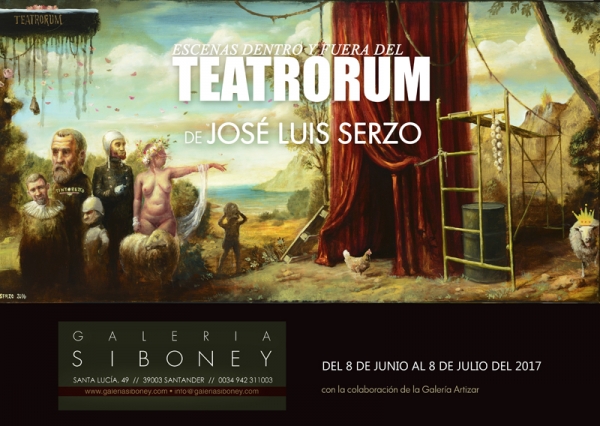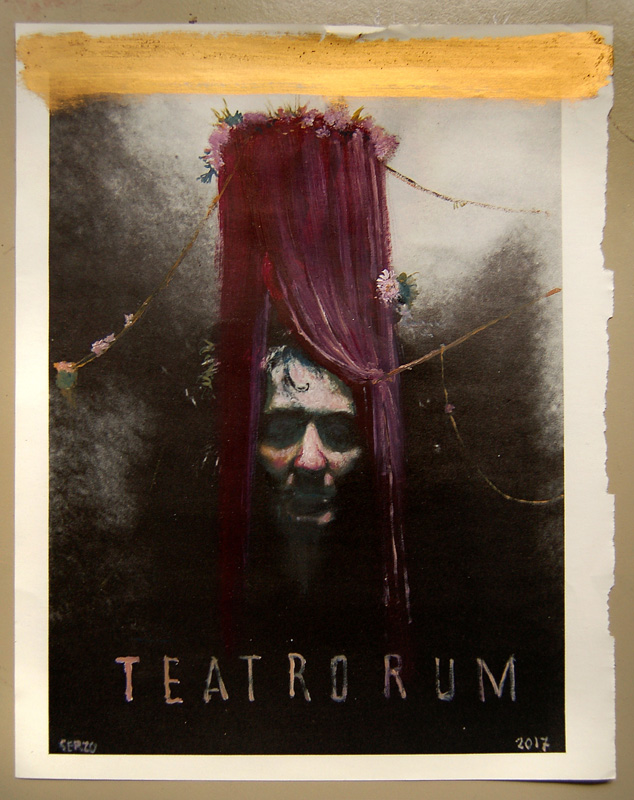From 8 June to 8 July 2017
Siboney Gallery. Santander

The Siboney Gallery presents “Escenas dentro y fuera del Teatrorum”, an exhibition that proposes a transversal reading of the wide production of José LuisSerzo (Albacete, 1977), one of the most outstanding and recognized Spanish artists of his generation, and linked to the gallery since its beginnings. In some way this exhibition commemorates his first show in Santander, (“Familasia, la isla de los virtuosos”) which took place exactly ten years ago, and which was possibly the most remembered exhibition in the gallery’s space in Calle Castelar, of the almost three hundred exhibitions presented there.
Although to be fair, the last exhibition of the artist, has been in the Palacete del Embarcadero last year, when it was presented the exhibition included in the program curated by Oscar Alonso Molina and carried out by the ABC Museum and the Banco Santander Foundation, which was entitled “Essays for a great work”, where he showed us for the first time in a monographic way a fundamental facet of his work: the drawing.
In this new show, which will open on Thursday 8 June, a multidisciplinary creator who understands his work as a whole as a great story, as in the main series that have marked his career, is honoured by his fame: “Post-Show” (2001-2003), “Familasia” (2007), “Los Sueños de I Ming” (2008), “Thewelcome” (2005-2009), “La historia más bellas jamás contada” (2010), “Los señores del bosque” (2011-2014), “Ensayos para una gran obra”(2015) or “El sueño del rey de la república” (2014-2016), among others. All of these series have generated a dense, vivifying and hopeful plot; in this sense, behind the recurring motif of the theatrical, which the Manchego artist uses naturally in all of his production, deeper questions are revealed where the imagination always proceeds as a revolutionary and transforming tool of reality.
This is the text for this new exhibition, written by Carmen Quijano:
In search of the goldfish “Ideas are like fish. If you want to catch little fish, you can stay in shallow water. But if you want to catch a big goldfish, you have to go into deeper water. In the depths, the fish are more powerful and pure. They’re huge and abstract. And very beautiful. […] Everything, anything, emerges from the deepest level. Modern physics calls that level a unified field. The more the consciousness expands, the deeper it goes into that source and the more fish can be caught.” Catch the goldfish, David Lynch Under the title Teatrorum, an exhaustive work of immersion and reflection on the prolific career of the artist José Luis Serzo was presented more than a year ago at the Domus Artium in Salamanca. This exhibition showed a kaleidoscopic narrative through his most representative series, which allowed us to investigate the depths of a highly metaphorical, symbolic work full of personal references. This exhibition, conceived by a choral curatorship, as it could not be otherwise for a task of such titanic characteristics, was a point of inflection and growth, a new catharsis in his artistic and personal evolution, a reaffirmation that life and art are part of the same framework. Teatrorum not only refers to a physical structure in the form of a temple or canopy, but also encompasses an individual experience that transcends the purely physical, becoming the fusion of the earthly plane with the spiritual. The two meanings were intertwined and made real in the Domus Artium exhibition with the construction of a spectacular theatrorum, a large circular structure that closed in on itself, held up by scaffolding, with open curtains that invited the spectator, in an active way, to get inside this architecture to raise their eyes and contemplate a spectacular break in glory. Serzo built a space where to reach the catharsis, a place where to change the sense of what was happening to a new state where the illusory took on special relevance and the border between reality and fantasy was attenuated. It is inevitable, when contemplating this great installation, not to think of the great ephemeral constructions made during the baroque period. Large provisional structures were dreamt up to glorify important public events such as official acts, political and religious events… They gave free rein to the imagination and allowed certain licenses that could happen because the constructions were perishable and transitory, so we have only received a few drawings and stories from them. But beyond the exhibition in the Domus Atrium, Teatrorum is a transversal concept in Serzo’s work, which has been present in many of his works and series as the search for the essential and profound, a moment of change. The pieces that make up Scenes and Events inside and outside a Teatrorum in the Siboney Gallery are presented as a series of studies, sketches and small works that show what is inside and outside the narrative. It reveals to us, because it has nothing to hide, the framework of its universe, the backstage of creation, revealing the process itself. In this sense, it is very interesting to be able to see the different sketches made for the elaboration of the piece Teatrorum, the models for a portable teatrorum or one that emerges from the depths of the sea. Multiple visions and studies that reinforce the idea of the teatrorum as an act or event. All the pieces make up a cabinet that delves into Serzo’s most intimate universe, in which the imaginary and the real are mixed to generate narratives that do not stop talking about his inner and outer world. This world has been shaped by his past, his childhood, his family and all the subsequent experiences. His work is full of symbols that are joined together to generate allegorical compositions that have a continuity in time as infinite stories. When I contemplate José Luis Serzo’s work with a certain calm and awareness, as when I watch David Lynch’s films, I am reminded of the moment when I am lying in bed and I suddenly fall asleep. Every day I fall into an experience that takes me to other universes in which, without knowing very well why, characters from my daily life are combined in scenes that miss me and make me wonder if I’m dreaming or awake. Waking moments in which I can fly, or try to fly, and others in which I can give free rein to my most perverse fantasies. I sincerely believe that it is an act of courage to show everything that belongs to the most private, to undress in front of others, to let the deepest part of you be seen. If we observe Serzo’s work from the surface, it is hopeful, vitalist, strange and virtuous. But if our intention as a spectator is to “catch the goldfish” we have to practice a conscious look, place ourselves on the other side, positioning ourselves from an attitude free of prejudice, let the characters talk to us about their story, submerge ourselves, in short, in the deepest waters of their universe.

